Abstract
Purpose
Based on a unique phase alignment that occurs during formulation, we postulated that PEG-ylation of the cargo enzyme would enhance its encapsulation within diblock copolymer nanocarriers and thus resistance to proteases.
Methods
A freeze–thaw modified double emulsion technique was utilized to encapsulate either the catalytically active enzyme catalase (MW ∼250 kDa) or PEG-catalase in PEG–PLA polymer nanocarriers (PNC). Spectrophotometer measurement of substrate depletion was utilized to monitor enzyme activity. Isotope labeling of the enzyme was used in conjunction with activity measurements to determine PNC loading efficiency and PNC-enzyme resistance to proteases. This labeling also enabled blood clearance measurements of PNC-loaded and non-loaded enzymes in mice.
Results
Non-loaded PEG-catalase exhibited longer circulation times than catalase, but was equally susceptible to proteolysis. Modulation of the ratio of relatively hydrophilic to hydrophobic domains in the diblock PEG–PLA copolymer provided either filamentous or spherical PNC loaded with PEG-catalase. For both PNC geometries, encapsulation and resistance to proteases of the resultant PNC-loaded enzyme were more effective for PEG-catalase than catalase. Isotope tracing showed similar blood levels of PNC-loaded and free PEG-catalase in mice.
Conclusions
PEGylation enhances active catalase loading within PNC and resistance to protease degradation, relative to unloaded PEG-catalase.





Similar content being viewed by others
Abbreviations
- DCM:
-
dichloromethane
- MW:
-
molecular weight
- PEG-cat:
-
Peg-Catalase
- PEG:
-
poly(ethylene glycol)
- PLA:
-
poly(lactic acid)
- PLGA:
-
poly(lactic-co-glycolic acid)
- PNC:
-
polymer nanocarrier
- PVA:
-
poly(vinyl alcohol)
- THF:
-
tetrahydrofuran
References
S. M. Moghimi, A. C. Hunter, and J. C. Murray. Long-circulating and target-specific nanoparticles: theory to practice. Pharmacol. Rev. 53:283–318 (2001).
S. M. Moghimi, and J. Szebeni. Stealth liposomes and long circulating nanoparticles: critical issues in pharmacokinetics, opsonization and protein-binding properties. Prog. Lipid Res. 42:463–478 (2003) doi:10.1016/S0163-7827(03)00033-X.
E. Roux, M. Lafleur, E. Lataste, P. Moreau, and J. C. Leroux. On the characterization of pH-sensitive liposome/polymer complexes. Biomacromolecules. 4:240–248 (2003) doi:10.1021/bm025651x.
V. R. Muzykantov. Targeting of superoxide dismutase and catalase to vascular endothelium. J. Control. Release. 71:1–21 (2001) doi:10.1016/S0168-3659(01)00215-2.
M. Christofidou-Solomidou, A. Scherpereel, R. Wiewrodt, K. Ng, T. Sweitzer, E. Arguiri, V. Shuvaev, C. C. Solomides, S. M. Albelda, and V. R. Muzykantov. PECAM-directed delivery of catalase to endothelium protects against pulmonary vascular oxidative stress. Am. J. Physiol. Lung Cell. Mol. Physiol. 285:L283–L292 (2003).
B. D. Kozower, M. Christofidou-Solomidou, T. D. Sweitzer, S. Muro, D. G. Buerk, C. C. Solomides, S. M. Albelda, G. A. Patterson, and V. R. Muzykantov. Immunotargeting of catalase to the pulmonary endothelium alleviates oxidative stress and reduces acute lung transplantation injury. Nat. Biotechnol. 21:392–398 (2003) doi:10.1038/nbt806.
K. Nowak, S. Weih, R. Metzger, R. F. Albrecht 2nd, S. Post, P. Hohenberger, M. M. Gebhard, and S. M. Danilov. Immunotargeting of catalase to lung endothelium via anti-angiotensin-converting enzyme antibodies attenuates ischemia-reperfusion injury of the lung in vivo. Am. J. Physiol. Lung Cell. Mol. Physiol. 293:L162–L169 (2007) doi:10.1152/ajplung.00001.2007.
S. Muro, X. Cui, C. Gajewski, J. C. Murciano, V. R. Muzykantov, and M. Koval. Slow intracellular trafficking of catalase nanoparticles targeted to ICAM-1 protects endothelial cells from oxidative stress. Am. J. Physiol. Cell. Physiol. 285:C1339–C1147 (2003).
A. M. Klibanov. Enzyme stabilization by immobilization. Anal. Biochem. 93:1–25 (1979) doi:10.1016/S0003-2697(79)80110-4.
V. P. Torchilin, E. G. Tischenko, V. N. Smirnov, and E. I. Chazov. Immobilization of enzymes on slowly soluble carriers. J. Biomed. Mater Res. 11:223–235 (1977) doi:10.1002/jbm.820110208.
T. D. Dziubla, A. Karim, and V. R. Muzykantov. Polymer nanocarriers protecting active enzyme cargo against proteolysis. J. Control. Release. 102:427–439 (2005) doi:10.1016/j.jconrel.2004.10.017.
R. Langer. Drug delivery and targeting. Nature. 392:5–10 (1998).
T. D. Dziubla, V. V. Shuvaev, N. K. Hong, B. J. Hawkins, M. Madesh, H. Takano, E. A. Simone, M. T. Nakada, A. Fisher, S. M. Albelda, and V. R. Muzykantov. Endothelial targeting of semi-permeable polymer nanocarriers for enzyme therapies. Biomaterials. 29:215–227 (2008)doi:10.1016/j.biomaterials.2007.09.023.
L. C. Seaver, and J. A. Imlay. Hydrogen peroxide fluxes and compartmentalization inside growing Escherichia coli. J. Bacteriol. 183:7182–7189 (2001) doi:10.1128/JB.183.24.7182-7189.2001.
E. A. Simone, T. D. Dziubla, F. Colon-Gonzalez, D. E. Discher, and V. R. Muzykantov. Effect of polymer amphiphilicity on loading of a therapeutic enzyme into protective filamentous and spherical polymer nanocarriers. Biomacromolecules. 8:3914–3921 (2007) doi:10.1021/bm700888h.
A. Hillgren, and M. Alden. Differential scanning calorimetry investigation of formation of poly(ethylene glycol) hydrate with controlled freeze-thawing of aqueous protein solution. J. Appl. Polym. Sci. 91:1626–1634 (2004) doi:10.1002/app.13249.
C. Branca, S. Magazu, G. Maisano, F. Migliardo, P. Migliardo, and G. Romeo. Hydration study of PEG/water mixtures by quasi elastic light scattering, acoustic and rheological measurements. J. Phys. Chem. B. 106:10272–10276 (2002) doi:10.1021/jp014345v.
A. M. Bellocq. Phase equilibria of polymer-containing microemulsions. Langmuir. 14:3730–3739 (1998) doi:10.1021/la970821q.
C. L. Bell, and N. A. Peppas. Water, solute and protein diffusion in physiologically responsive hydrogels of poly (methacrylic acid-g-ethylene glycol). Biomaterials. 17:1203–1218 (1996) doi:10.1016/0142-9612(96)84941-6.
V. V. Shuvaev, T. Dziubla, R. Wiewrodt, and V. R. Muzykantov. Streptavidin-biotin cross linking of therapeutic enzymes with carrier antibodies: nanoconjugates for protection against endothelial oxidative stress. Methods Mol. Biol. 283:3–19 (2004).
R. F. Beers Jr., and I. W. Sizer. A spectrophotometric method for measuring the breakdown of hydrogen peroxide by catalase. J. Biol. Chem. 195:133–140 (1952).
S. B. Barker, and W. H. Summerson. The colorimetric determination of lactic acid in biological material. J. Biol. Chem. 138:535–554 (1941).
P. Dalhaimer, F. S. Bates, and D. E. Discher. Single molecule visualization of stable, stiffness-tunable, flow-conforming worm micelles. Macromolecules. 36:6873–6877 (2003) doi:10.1021/ma034120d.
J. S. Beckman, R. L. Minor Jr., C. W. White, J. E. Repine, G. M. Rosen, and B. A. Freeman. Superoxide dismutase and catalase conjugated to polyethylene glycol increases endothelial enzyme activity and oxidant resistance. J. Biol. Chem. 263:6884–6892 (1988).
A. Abuchowski, J. R. McCoy, N. C. Palczuk, T. van Es, and F. F. Davis. Effect of covalent attachment of polyethylene glycol on immunogenicity and circulating life of bovine liver catalase. J. Biol. Chem. 252:3582–3586 (1977).
P. S. Pyatak, A. Abuchowski, and F. F. Davis. Preparation of a polyethylene glycol: superoxide dismutase adduct, and an examination of its blood circulation life and anti-inflammatory activity. Res. Commun. Chem. Pathol. Pharmacol. 29:113–127 (1980).
J. S. Beckman, R. L. Minor Jr., and B. A. Freeman. Augmentation of antioxidant enzymes in vascular endothelium. J. Free Radic. Biol. Med. 2:359–365 (1986) doi:10.1016/S0748-5514(86)80036-8.
T. Minko, P. V. Paranjpe, B. Qiu, A. Lalloo, R. Won, S. Stein, and P. J. Sinko. Enhancing the anticancer efficacy of camptothecin using biotinylated poly(ethylene glycol) conjugates in sensitive and multidrug-resistant human ovarian carcinoma cells. Cancer Chemother. Pharmacol. 50:143–150 (2002) doi:10.1007/s00280-002-0463-1.
S. V. Vinogradov, T. K. Bronich, and A. V. Kabanov. Self-assembly of polyamine-poly(ethylene glycol) copolymers with phosphorothioate oligonucleotides. Bioconjug. Chem. 9:805–812 (1998) doi:10.1021/bc980048q.
I. J. Castellanos, R. Crespo, and K. Griebenow. Poly(ethylene glycol) as stabilizer and emulsifying agent: a novel stabilization approach preventing aggregation and inactivation of proteins upon encapsulation in bioerodible polyester microspheres. J. Control. Release. 88:135–145 (2003) doi:10.1016/S0168-3659(02)00488-1.
M. Diwan, and T. G. Park. Pegylation enhances protein stability during encapsulation in PLGA microspheres. J. Control. Release. 73:233–244 (2001) doi:10.1016/S0168-3659(01)00292-9.
M. Diwan, and T. G. Park. Stabilization of recombinant interferon-alpha by pegylation for encapsulation in PLGA microspheres. Int. J. Pharm. 252:111–122 (2003) doi:10.1016/S0378-5173(02)00636-1.
W. Wasfi Al-Azzam, E. A. Pastranna, B. King, J. Méndez, and K. Griebenow. Effect of the covalent modification of horseradish peroxidase with poly(ethylene glycol) on the activity and stability upon encapsulation in polyester microspheres. J. Pharm. Sci. 94:1808–1819 (2005) doi:10.1002/jps.20407.
T. H. Kim, H. Lee, and T. G. Park. Pegylated recombinant human epidermal growth factor (rhEGF) for sustained release from biodegradable PLGA microspheres. Biomaterials. 23:2311–2317 (2002) doi:10.1016/S0142-9612(01)00365-9.
A. Abuchowski, T. van Es, N. C. Palczuk, and F. F. Davis. Alteration of immunological properties of bovine serum albumin by covalent attachment of polyethylene glycol. J. Biol. Chem. 252:3578–3581 (1977).
D. J. McClements. Protein-stabilized emulsions. Curr. Opin. Colloid Interface Sci. 9:305–313 (2004) doi:10.1016/j.cocis.2004.09.003.
I. Fuke, T. Hayashi, Y. Tabata, and Y. Ikada. Synthesis of poly(ethylene glycol) derivatives with different branchings and their use for protein modification. J. Control. Release. 30:27–34 (1994) doi:10.1016/0168-3659(94)90041-8.
R. Federico, A. Cona, P. Caliceti, and F. M. Veronese. Histaminase PEGylation: preparation and characterization of a new bioconjugate for therapeutic application. J. Control. Release. 115:168–174 (2006) doi:10.1016/j.jconrel.2006.07.020.
F. M. Veronese, C. Monfardini, P. Caliceti, O. Schiavon, M. D. Scrawen, and D. Beer. Improvement of pharmacokinetic, immunological and stability properties of asparaginase by conjugation to linear and branched monomethoxy poly (ethylene glycol). J. Control. Release. 40:199–209 (1996) doi:10.1016/0168-3659(95)00185-9.
F. M. Veronese, P. Caliceti, A. Pastorino, O. Schiavon, L. Sartore, L. Banci, and L. M. Scolaro. Preparation, physico-chemical and pharmacokinetic characterization of monomethoxypoly(ethylene glycol)-derivatized superoxide dismutase. J. Control. Release. 10:145–154 (1989) doi:10.1016/0168-3659(89)90025-4.
F. Fuertges, and A. Abuchowski. The clinical efficacy of poly(ethylene glycol)-modified proteins. J. Control. Release. 11:139–148 (1990) doi:10.1016/0168-3659(90)90127-F.
D. Dikovsky, H. Bianco-Peled, and D. Seliktar. Defining the role of matrix compliance and proteolysis in three-dimensional cell spreading and remodeling. Biophys. J. 94:2914–2525 (2008).
M. Gonen-Wadmany, L. Oss-Ronen, and D. Seliktar. Protein-polymer conjugates for forming photopolymerizable biomimetic hydrogels for tissue engineering. Biomaterials. 28:3876–3886 (2007) doi:10.1016/j.biomaterials.2007.05.005.
D. Dikovsky, H. Bianco-Peled, and D. Seliktar. The effect of structural alterations of PEG-fibrinogen hydrogel scaffolds on 3-D cellular morphology and cellular migration. Biomaterials. 27:1496–1506 (2006) doi:10.1016/j.biomaterials.2005.09.038.
H.-C. Chiu, C. Konak, P. Kopeckova, and J. Kopecek. Enzymatic degradation of poly(ethylene glycol) modified dextrans. J. Bioact. Compat. Polym. 9:388–410 (1994) doi:10.1177/088391159400900403.
X. Y. Xiong, K. C. Tam, and L. H. Gan. Effect of enzymatic degradation on the release kinetics of model drug from Pluronic F127/poly(lactic acid) nano-particles. J. Control. Release. 108:263–270 (2005) doi:10.1016/j.jconrel.2005.08.005.
O. Schiavon, P. Caliceti, P. Ferruti, and F. M. Veronese. Therapeutic proteins: a comparison of chemical and biological properties of uricase conjugated to linear or branched poly(ethylene glycol) and poly(N-acryloylmorpholine). Farmaco. 55:264–269 (2000) doi:10.1016/S0014-827X(00)00031-8.
C. Monfardini, O. Schiavon, P. Caliceti, M. Morpurgo, J. M. Harris, and F. M. Veronese. A branched monomethoxypoly(ethylene glycol) for protein modification. Bioconjug. Chem. 6:62–69 (1995) doi:10.1021/bc00031a006.
Y. Ren, H. Zhang, and J. Huang. Synthesis and cytotoxic activity of platinum complex immobilized by branched polyethylene glycol. Bioorg. Med. Chem. Lett. 15:4479–4483 (2005) doi:10.1016/j.bmcl.2005.07.019.
Y. Geng, P. Dalhaimer, S. Cai, R. Tsai, M. Tewari, T. Minko, and D. E. Discher. Shape effects of filaments versus spherical particles in flow and drug delivery. Nat. Nano. 2:249–255 (2007) doi:10.1038/nnano.2007.70.
S. Cai, K. Vijayan, D. Cheng, E. M. Lima, and D. E. Discher. Micelles of different morphologies-advantages of worm-like filomicelles of PEO-PCL in paclitaxel delivery. Pharm. Res. 24:2099–2109 (2007).
Acknowledgement
This work was supported by grants from the National Institutes of Health (NIH #’s HL007954, HL073940-01-A1, HL087036 and PO1-HL079063). We thank Tony Lowman and the Centralized Materials Characterization Facility and Industry Consortium of Drexel University for assistance with NMR and SEM studies and Dennis Discher of the University of Pennsylvania for GPC studies.
Author information
Authors and Affiliations
Corresponding author
Rights and permissions
About this article
Cite this article
Simone, E.A., Dziubla, T.D., Arguiri, E. et al. Loading PEG-Catalase into Filamentous and Spherical Polymer Nanocarriers. Pharm Res 26, 250–260 (2009). https://doi.org/10.1007/s11095-008-9744-7
Received:
Accepted:
Published:
Issue Date:
DOI: https://doi.org/10.1007/s11095-008-9744-7




